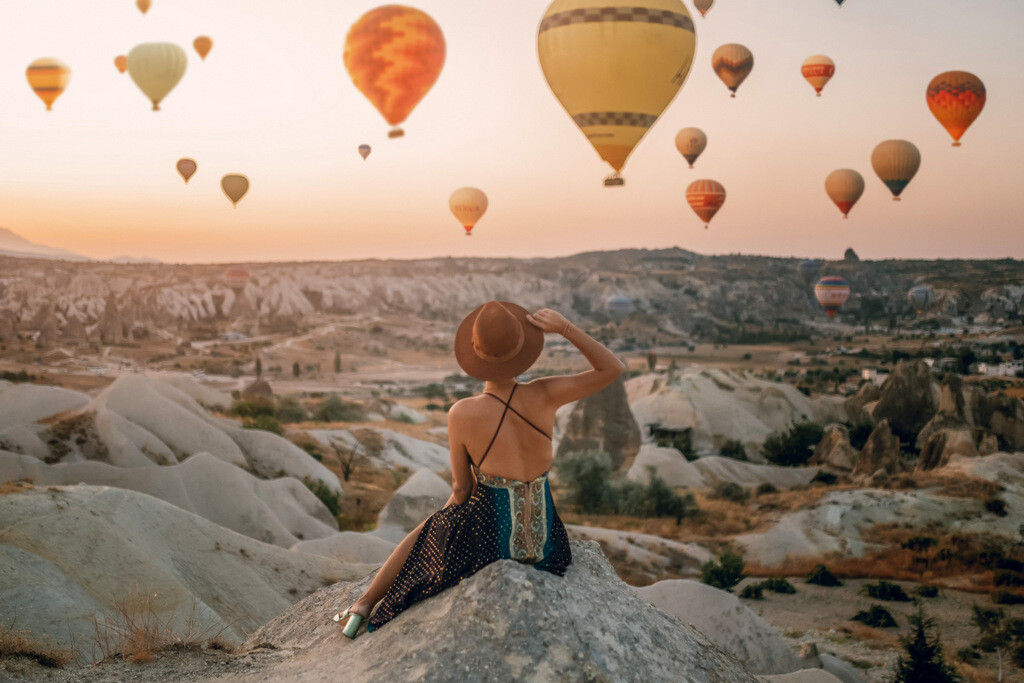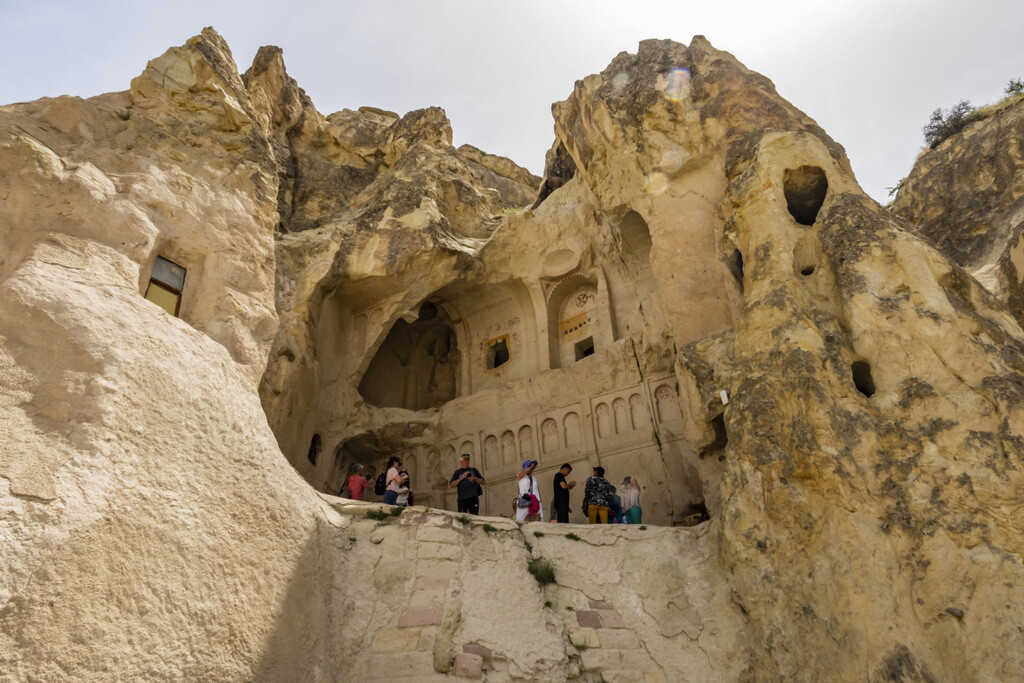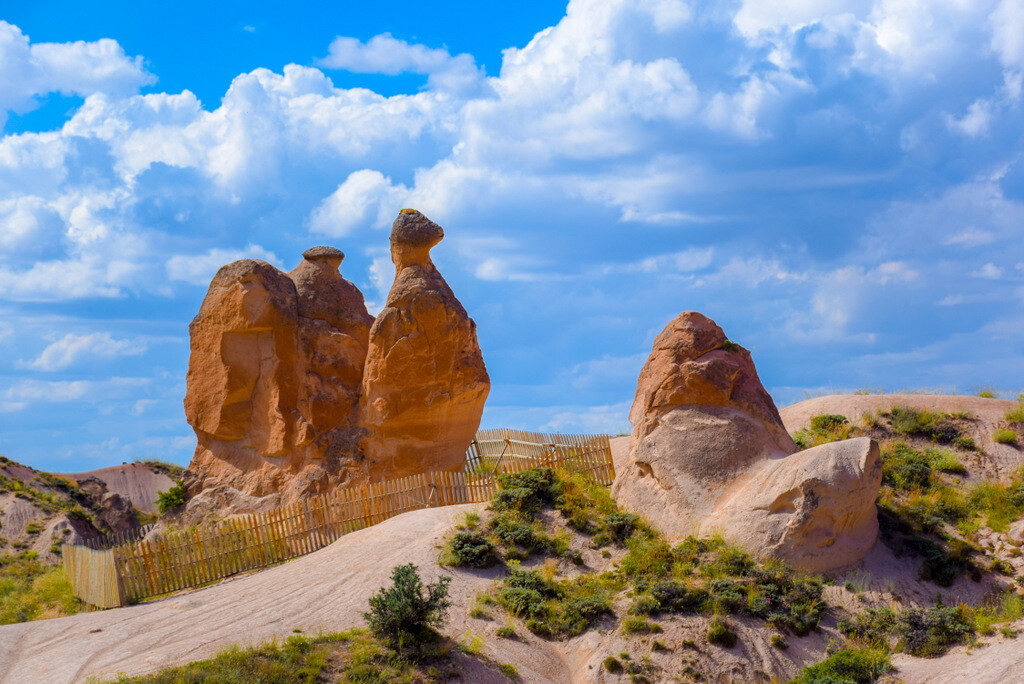Cappadocia travel blog includes valleys, hills, underground cities and rock churches of Cappadocia. As a professional tour guide, I have listed the top 20 things to do in Cappadocia for you.
The unique landforms in Cappadocia were formed by wind and rain eroding the soft lava layer erupting from the Erciyes, Gullu and Hasan Mountains over the centuries. Cappadocia is a region located in the heart of Anatolia and covers a wide area spread over the cities of Nevsehir, Kayseri, Aksaray and Nigde.
Those who want to travel to Turkey usually start from Istanbul. If you want to go to Cappadocia after visiting Istanbul, traveling by plane is the most practical way. From Istanbul, you can reach Cappadocia Airport in Nevsehir in just one hour and twenty minutes.
Cappadocia can be visited in all seasons thanks to the winter season which is not too cold. Visiting Cappadocia in different seasons can give you different experiences. Snow-covered hills and fairy chimneys in winter offer a spectacular view. On the other hand, trekking in Cappadocia in spring will give you great pleasure.
If you are wondering about the best time to visit Cappadocia, I can say that this is the spring and autumn months. In these months, the weather is neither hot nor cold. These are also the best times for trekking and ballooning.
Cappadocia Travel Blog 2024
Cappadocia promises a fairy tale experience with land forms that are nowhere else in the world. For this reason, I would recommend you to spend at least two days to visit Cappadocia.
You can find insider tips that can make your trip easier on the Cappadocia travel blog. You can see the best things to do in Cappadocia in 2024 under 20 headings in the lines below.
1. Goreme Open Air Museum
Although the first historical findings about Cappadocia date back to the Hittites period, the remains of the present day are mostly from the early Christian period.
After Jesus’ death in the 30s, his apostles entered Anatolia through Antioch and began to spread Christianity. The rapid spread of monotheistic belief disturbed the Roman authorities and triggered centuries of oppression against Christians.
The Christian communities who could not perform their worship found a suitable habitat in the geography of Cappadocia. Volcanic rocks, which can be easily shaped even with simple tools, made it possible to build various living spaces.
Goreme Open Air Museum sheds light on the life of early Christians. Buckle, Apple, Snake, Dark and St Barbara churches are among the main churches to visit in Goreme Museum.
The most popular among the rock churches in Goreme is the Dark Church. These churches were the most important centers of monastic life in Cappadocia throughout the Middle Ages.
There are many historically important valleys in Cappadocia. However, you can find the most popular valleys of the region in the following six headings of the Cappadocia travel blog.
2. Devrent Valley
Devrent Valley, also known as the imagination valley, is located in Avanos. Devrent, which is also neighboring Zelve and Monks Valleys, is a place that challenges your imagination.
The fairy chimneys are associated with various animal and human forms. Especially the fairy chimney that resembles a camel is very famous. Another fairy chimney is attributed to a praying nun or Virgin Mary with her hands opened.
3. Monks Valley
The Monks Valley (aka Pasabag Valley) became a place of hermits who wanted to move away from worldly life and focus on religion especially during the Byzantine Empire period.
In the Valley of the Monks, there is a church dedicated to a famous saint who lived in Syria in the 5th century. The ascetic saint, Simeon Stylites, lived for 37 years on a platform above a column and opened a new chapter in monkhood.
4. Zelve Valley
Only one kilometer from the Valley of the Monks, Zelve Valley is home to pointed and wide-bodied fairy chimneys. Zelve Valley was very popular among religious people who escaped from the city life during the Byzantine period.
Uzumlu, Balikli and Geyikli churches can be visited in the valley which was one of the religious centers of Byzantium in the Middle Ages. The extraordinary landforms of Zelve inspired the monks.
5. Pigeon Valley
Pigeon Valley (aka Guvercinlik Valley), which covers 4 kilometers between Uchisar and Goreme, is ideal for trekking, valley biking and yoga. The name of the valley comes from the nests where people carved the rocks for pigeons.
The people of the region used the fertilizer of these pigeons in the vineyards and their eggs in the plaster of the religious frescoes. Pigeon nests from that period can still be seen in the valley.
6. Ihlara Valley
Ihlara Valley was created when the Melendiz River eroded the soft rocks and formed a 14 km long canyon with a depth of 100 to 200 meters. It is estimated that the settlement in Ihlara Valley started in the 4th century.
Thanks to the unique geological features of the region, frescoed churches carved into the rocks have survived to the present day. It is possible to visit the magnificent churches in the depths of the valley. In order to reach these hidden treasures, you have to go down 397 steps.
7. Red and Rose Valleys
Red and Rose Valleys are two neighboring valleys. Located between Cavusin and Goreme, Rose (Gulludere) Valley is home to many churches and monastery ruins. Rose Valley is a 4-kilometer trekking trail where fairy chimneys can be best viewed. Church Of Three Crosses and Ayvali Church can be seen as a heritage of Christianity.
The Red (Kizilcukur) Valley takes its name from red pumice rocks. The valley, which turns into a red color at sunset, is the best place to watch the sunset in Cappadocia. Red Valley offers great opportunities for those who want to take an Instagram photos in Cappadocia.
You can find the four most popular towns of the region in the next 4 titles of the Cappadocia travel blog. Each of these towns stands out with its own unique features.
8. Avanos
Avanos is one of the oldest pottery centers in the world. Pottery, one of the discoveries of the Neolithic, enabled people to keep enough food to protect them from famine. Pottery obtained by shaping the soil collected from the bed of the Kizilirmak (Red River) is an art that has existed in Avanos since the Hittites.
Attending pottery workshops in Avanos is among the fun things to do in Cappadocia. You can have a great time in short-term presentations and workshops for tourists. This activity is included in the program for most of the guided tours of Cappadocia. You can find advice on tours on the bottom lines.
9. Cavusin Village
Cavusin Village is located just 2 kilometers from Goreme. Cavusin, one of the oldest settlements in the Cappadocia region, is an ancient Christian settlement. There are important churches in the village, where early Christians escaped from the Roman soldiers.
The main churches to be seen in Cavusin are the Cavusin Church, and the Church of John the Baptist. In addition, the entrance of the Red & Rose valleys starts from Cavusin.
10. Urgup
Urgup is a place where you can see the most beautiful examples of stone houses of the region. When you go to Urgup’s town center, one of the things you will notice is Temenni Hill. On this hill, you can see the most prominent Seljuk and Ottoman monuments in Cappadocia.
Urgup came to the fore with a Turkish TV series years ago. If you have heard of this TV series called Asmali Konak, the house where the series was shot can still be visited.
11. Mustafapasa
Mustafapasa (aka Sinasos), located in Urgup, was a town where the Christian people lived until 1924. After the first world war, Christians left the town because of the population exchange between Turkey and Greece.
Christians who lived in Mustafapasa left many churches and mansions built with local stonemasonry. Mustafapasa, which was named Sinasos in antiquity, is worth visiting for the churches of St. George, St. Basil, St. Stefanos and Church of Constantine and Helena (this church can be seen in the picture above).
There are 35 underground cities in the entire Cappadocia region. Underground cities used to be a shelter for early Christians to escape the Roman persecution. The next two titles of the Cappadocia travel blog introduce the two most famous underground cities.
12. Derinkuyu Underground City
Derinkuyu Underground City was designed as an underground shelter for people to live in emergencies. In this underground city, which is 85 meters deep, there are food stores, wine cellars, water wells and meeting rooms. There is even a ventilation system for settlers to survive raids.
Derinkuyu was designed for the early Christians who escaped from the Roman soldiers when it was first built, so there is a baptistery, a missionary school and even a place of confession. In the middle ages it was used by the Byzantine people to protect them from the Arab raids.
13. Kaymakli Underground City
Kaymakli Underground City was built in 1200 BC during the Hittites. Everything was masterfully planned in this underground city. When you visit Kaymakli, which has a capacity of five thousand people, you will witness a very organized city plan.
Visiting the castles is one of the most interesting things to do in Cappadocia. The living spaces carved into the hills have been home to thousands of people. The next two topics of the Cappadocia travel blog will introduce the famous hills of the region.
14. Uchisar Castle
Uchisar Castle is the highest point where you can watch Cappadocia. It was a fortress created by Christians fleeing the persecution of the Roman authorities. The settlers carved the rocks and created living spaces for themselves.
In Cappadocia there is also Ortahisar Castle, which is slightly smaller than Uchisar. In the past, when one of these two castles was attacked by an enemy, there was an underground tunnel that allowed the people to escape to the other castle.
Uchisar can be seen in many parts of Cappadocia due to its height. It is only possible to watch Cappadocia from a higher point than Uchisar by participating in a balloon flight.
15. Ortahisar Castle
Ortahisar Castle, from a distance, looks like the biggest fairy chimney of the entire Cappadocia region. The shaping of this gigantic rock by human hands first began with the aim of protection during the Hittites. It served as a strong fortress during the Roman and Byzantine periods.
Ortahisar stands out as the most popular place for foreigners to live in Cappadocia. The foreigners who came to visit Cappadocia and were fascinated by the region bought and restored stone houses in this town and started to live here.
The next three topics of the Cappadocia travel blog are about unique things to do in Cappadocia. These three must-see places are also among the most photographed places in Cappadocia.
16. Three Beauties
These three fairy chimneys, which have become the symbol of Cappadocia, are called Three Beauties. The Three Graces are the most beautiful examples of the fairy chimneys with mushroom-shaped cap. One of Cappadocia’s most shared instagram photos is the Three Beauties.
17. Selime Monastery
Selime Monastery is located very close to Ihlara Valley. The monastery, which hosts 300,000 visitors a year, also served as a religious school in the Middle Ages.
The monastery, which carries the traces of early Christianity, has many chapels carved into the rocks as well as a cathedral. According to some historical records, the first loud Christian rite was held here.
18. Guray Ceramic Museum
Guray Ceramic Museum, the first and only underground ceramic museum in the world, introduces the cultural heritage of the region to its visitors. This museum is one of the experiences that will crown your travel to Cappadocia.
Tourists who come to the museum experience all the stages of pottery manufacturing and experience making pottery themselves. Guray Ceramic is the largest manufacturing and sales workshop in Cappadocia.
19. Cappadocia Hot Air Balloons
Cappadocia Hot Air Balloon flight is among the must-do things for adventurous travelers in Cappadocia. In Cappadocia, hot air balloon tours are held 365 days a year. However, the departure point and the route of the flights may vary depending on the daily weather.
Cappadocia Hot Air Balloon ride is made in the most beautiful places of Cappadocia such as Urgup, Goreme and Avanos. Thanks to the hot air balloon tours, it is possible to see the fascinating earth formations in Cappadocia from a height of several hundred meters.
20. Staying in the Cave Hotels
The most popular hotels to stay in the area are the Cappadocia cave hotels that are compatible with the region’s unique volcanic formations. In the last few decades when tourism developed rapidly in Cappadocia, beautiful boutique hotels were opened. Some of these hotels have received worldwide accommodation awards.
If you want to dig deeper on this subject, I suggest you to read the article on the best cave hotels in Cappadocia. It should also be noted that this link will direct you to another blog about Cappadocia.
Conclusion
Cappadocia is one of the must-see places for those visiting Turkey for the first time. The fabulous geography of the region has been attracting people like a magnet for thousands of years.
If you want to get more detailed information about Cappadocia, you can find many subheadings in the relevant category of Istanbul Clues website. In this section, there are more detailed articles about the places mentioned in the article.
If you want to organize a tour to go from Istanbul to Cappadocia, you can try this tour I recommend. This tour includes many of the best things to do in Cappadocia that we have mentioned so far on the Cappadocia travel blog.
Written by Serhat Engul




Leave a Reply